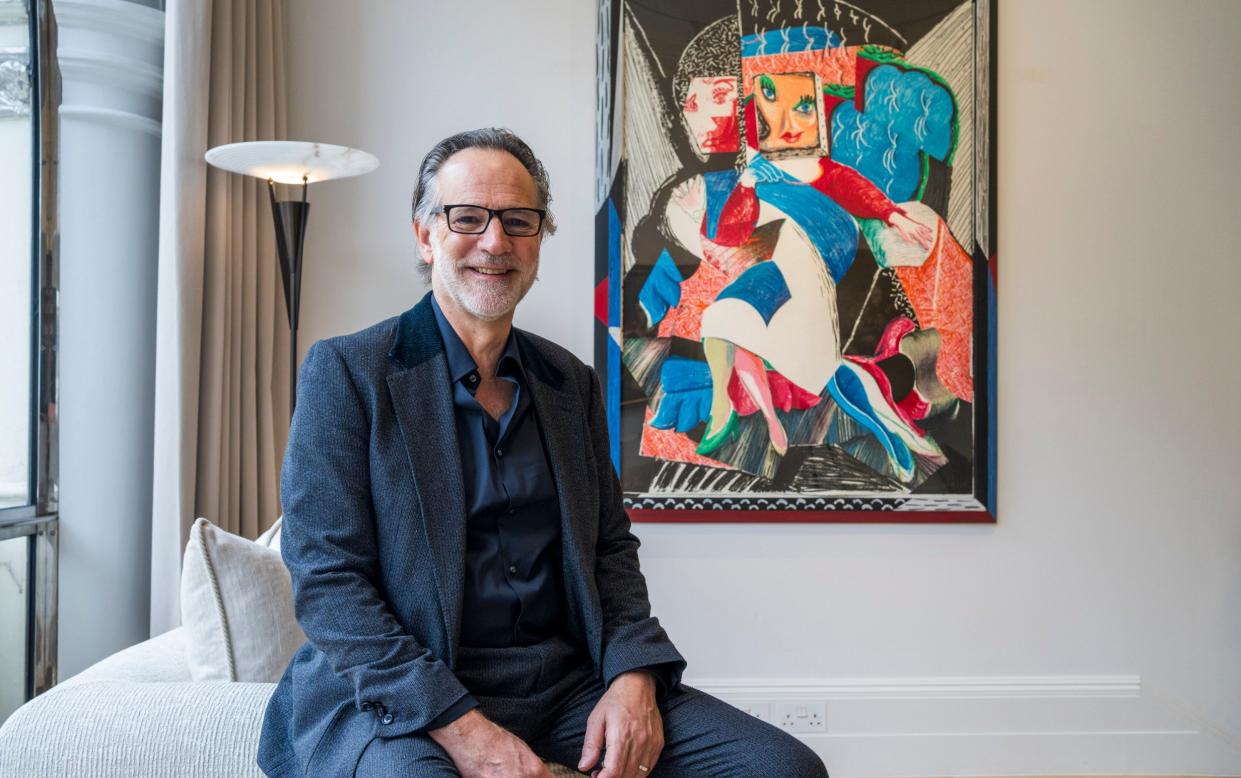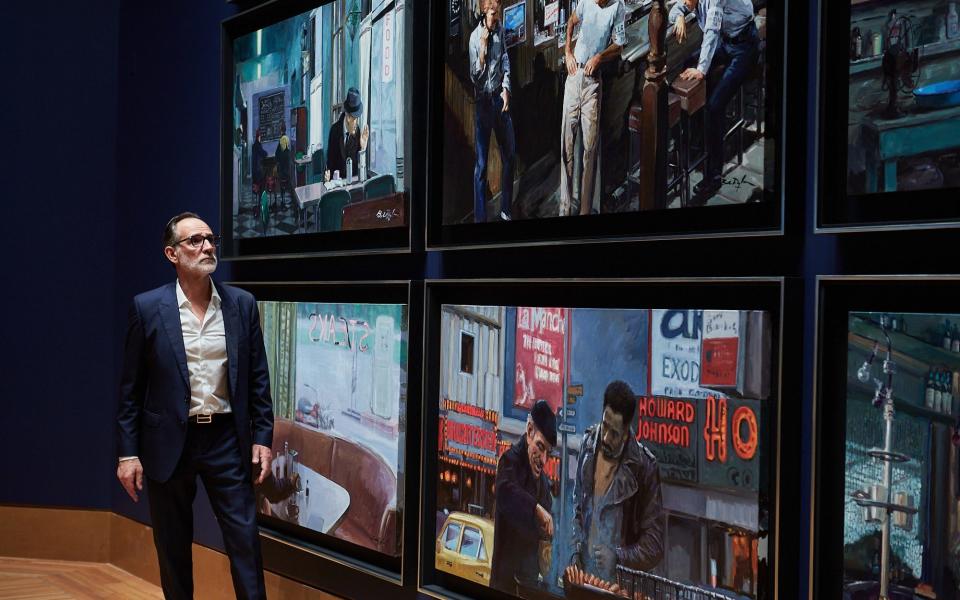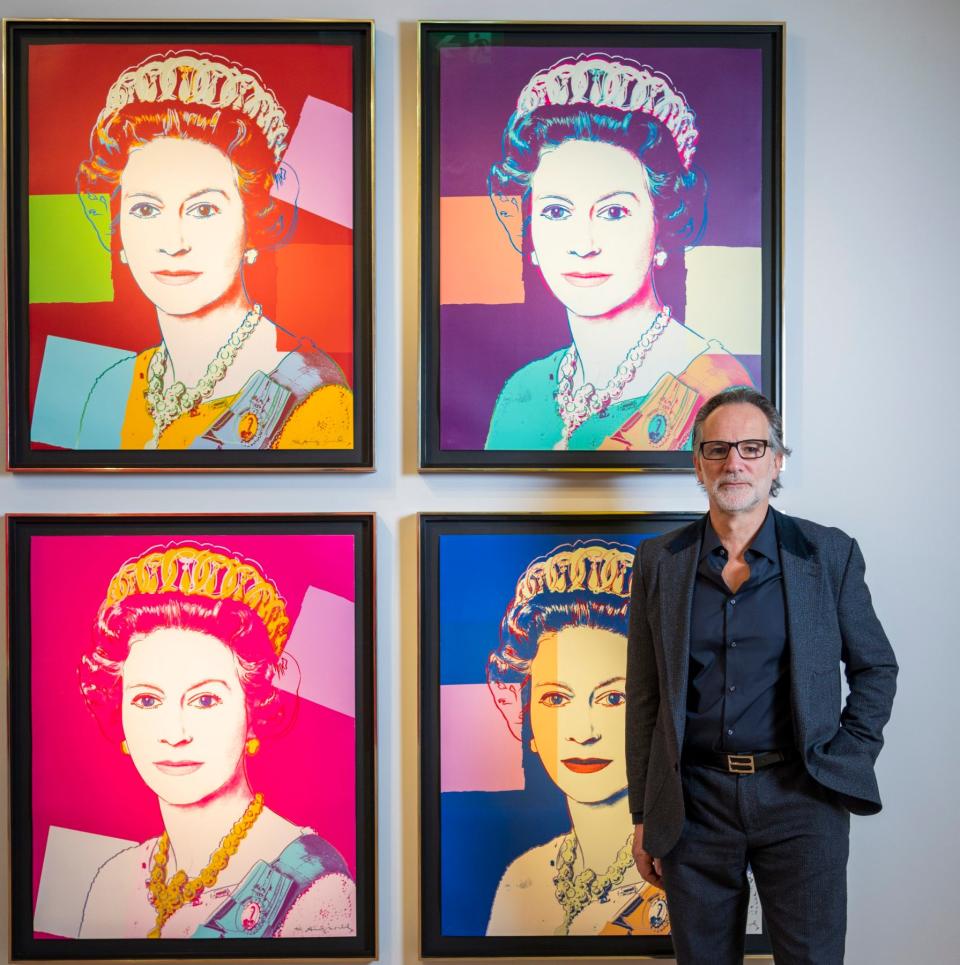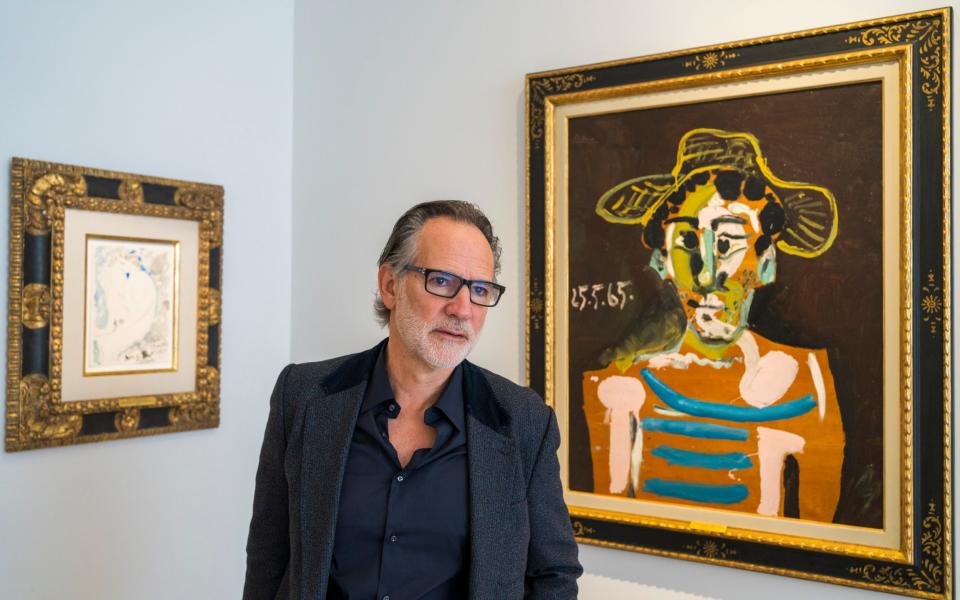Paul Green: ‘Prince Philip used to call me the arm‑twister’

- Oops!Something went wrong.Please try again later.
- Oops!Something went wrong.Please try again later.
- Oops!Something went wrong.Please try again later.
- Oops!Something went wrong.Please try again later.
“I’ve always fantasised about this building,” says Paul Green, the 60-something founder of the Halcyon Gallery, which sits among the high fashion stores of New Bond Street. Currently, across its expansive ground floor and airy basement, an exhibition of some of Andy Warhol’s most iconic lithographs and paintings is taking place – from portraits of Elizabeth II to reworkings of famous advertisements – and it’s attracting a crowd. “I’ve never wanted people to have to ring a doorbell to get in,” says Green, one of the art world’s more colourful characters. “We work hard on our shows and I want people to see them.”
Besides, as Green tells it, you never know who is a potential buyer. He casts his mind back to earlier days, when his gallery was above New Street Station in Birmingham. “One of our first successful sales was of a small painting by LS Lowry to a scruffy man in jeans,” he says. “Never judge a book by its cover.”
The building is historic: home to the Fine Art Society, an old and respected dealership, from its founding in 1876 until last year. When it became available, Green jumped, though he didn’t have far to come. Halcyon Gallery had been next door, where there is now a fancy new Gucci store, for over a decade, and started its London life round the corner, in nearby Bruton Street, back in 2002.
Both premises had seen a roll call of impressive visitors, among them the esteemed music producer Jimmy Iovine and the singer Bono. “He came to see the first Bob Dylan exhibition we put on, around 2006,” says Green of the U2 frontman. “He spent an hour walking around, singing his favourite Dylan songs. Then he invited me to a concert he was playing that night.” Another visitor, Johnny Depp, went on to join the gallery as an artist. “He likes to silk-screen,” says Green. Depp’s series Friends and Heroes (think Bob Marley, Liz Taylor, Al Pacino rendered in a naïve style) is for sale through Green’s print business Castle Fine Art, and it is not cheap.

As for Warhol, Green met him in New York in 1986, not long before he died. “He’d just produced Cowboys and Indians,” he says of a silk-screen series that is now on show downstairs. “He was hanging out with Mariel Hemmingway.” Among other exceptional works on show is an original Warhol portrait of Pelé, that the artist presented directly to the footballer, and Green has managed to acquire. “Thing is, we’re not just selling Warhol, we’re collecting Warhol,” explains Green who doesn’t have any work on consignment. The gallery owns every piece that is for sale.
Paul Green’s office is on a handsome first floor, where a huge semi-circular window lets in copious light as well as the sound of cheesy disco booming out from the pedal rickshaws that pull up at the traffic lights below. (“You can certainly have my opinion on that,” grimaces Green.) On the table is a platter of exquisite choux buns from Marchesi, the Prada-owned patisserie in nearby Mount Street. They are the size of a 2p piece and filled with pistachio cream.

Green is just as elegantly turned out – his father came from several generations of gentleman tailors before going into business with his son – as are the walls above his desk. There is a 1932 Picasso, a delicate watercolour of a bathing woman; and a 1909 Renoir of an idyllic country scene. But his remit is to mix old and new. “All living artists study dead artists, you can’t separate the two,” says Green.
To prove his point, he opened the new space last year with a state-of-the-art presentation by Dominic Harris, a London-based artist who creates huge screen-based works, massive moving chandeliers and completely immersive environments. “It took me seven years to get him on board,” says Green. “Eventually I said to him, how big can you dream? Then let’s do it! When we opened, the show got literally millions of TikTok views.”
Green’s art career was far from inevitable. Brought up in Birmingham, he left school after his A-levels and went to work on a kibbutz in Israel. A short spell at agricultural college in Cirencester followed and was not to Green’s liking. “It was the most prejudiced place I’d ever been – and there were no girls!” he exclaims. “I failed a soil exam and I left.” It was a casual job for a Canadian, which involved selling prints by the portrait painter Pietro Annigoni, that lured him in. “Annigoni was in Florence then, and he was the maestro. I really started to get interested in art,” says Green. One of the last royal painters of the 20th century, it was Annigoni who made the famous portrait of Elizabeth II enveloped in a navy riding cape, on a white horse. When Annigoni’s business began to fail, Green decided to set up a gallery in Birmingham.

Now Green travels all over the world, building major collections, visiting clients and museums who are interested in the work he has to offer. Last year he installed a large sculpture by Bob Dylan at Chateau La Coste, the extraordinary art park in the South of France developed by the hotelier Paddy McKillen (the man who made the Connaught and Claridges what they are today.) “It’s Dylan’s biggest art work,” explains Green. “A train car, created from a load of salvaged metal pieces, that takes him back to where he grew up in Minnesota.”
But other activities keep him equally busy. “I’m a huge sports fan,” admits Green. “I took my son to the Rugby World Cup in 2019. First time I’d been to Japan.” He also works hard raising funds for the Duke of Edinburgh award. “He was one of the world’s great human beings,” he says of Prince Philip, though he speaks equally positively of the new incumbent. “He used to heckle me when I was talking. Called me the arm-twister!”
With the business expanding to both New York and Los Angeles, there’s no letting up in Green’s world. “We’re converting an existing space on West Broadway,” he says, “and building 10,000 sq ft in Los Angeles, just off Rodeo Drive.” Meanwhile in the London gallery, Warhol will be followed by a new Bob Dylan show, and later in the year by one of our greatest printmakers, David Hockney.
“I don’t want to give too much away,” says Green. But he’d love you to come along and take a look. “It’s irrelevant how much money people have,” he says. “It’s all about the art.”
How to invest in art
Collecting tips from Paul Green
You can start by buying good quality prints; it’s still the real thing. Durer’s prints are incredibly valuable; Picasso made prints. Warhol is, of course, the master, and now Hockney.
Go to museums, visit exhibitions and start to work out what you really like. Museum posters make for great early acquisitions, and some even go on to be quite valuable, if it is a landmark show.
Take your kids! It’s never too early to start looking at art, and children often react in such a spontaneous way. When we had our Dominic Harris show, of screen-based and immersive works, the children who came were fearless and they loved it. They were always the first to interact with the works.
Looking online opens up a whole world of possibilities, but there’s nothing like the moment of interaction you have when you visit a gallery. Art is physical and it’s best seen in real life.
In some public galleries, the docents are well-trained and can talk to you about the work on show. In private galleries, feel free to ask anything. All the staff are there to help you understand the art better. Of course, you can ask the price too, but that can be irrelevant. And don’t be offended if a gallerist would rather not say.

